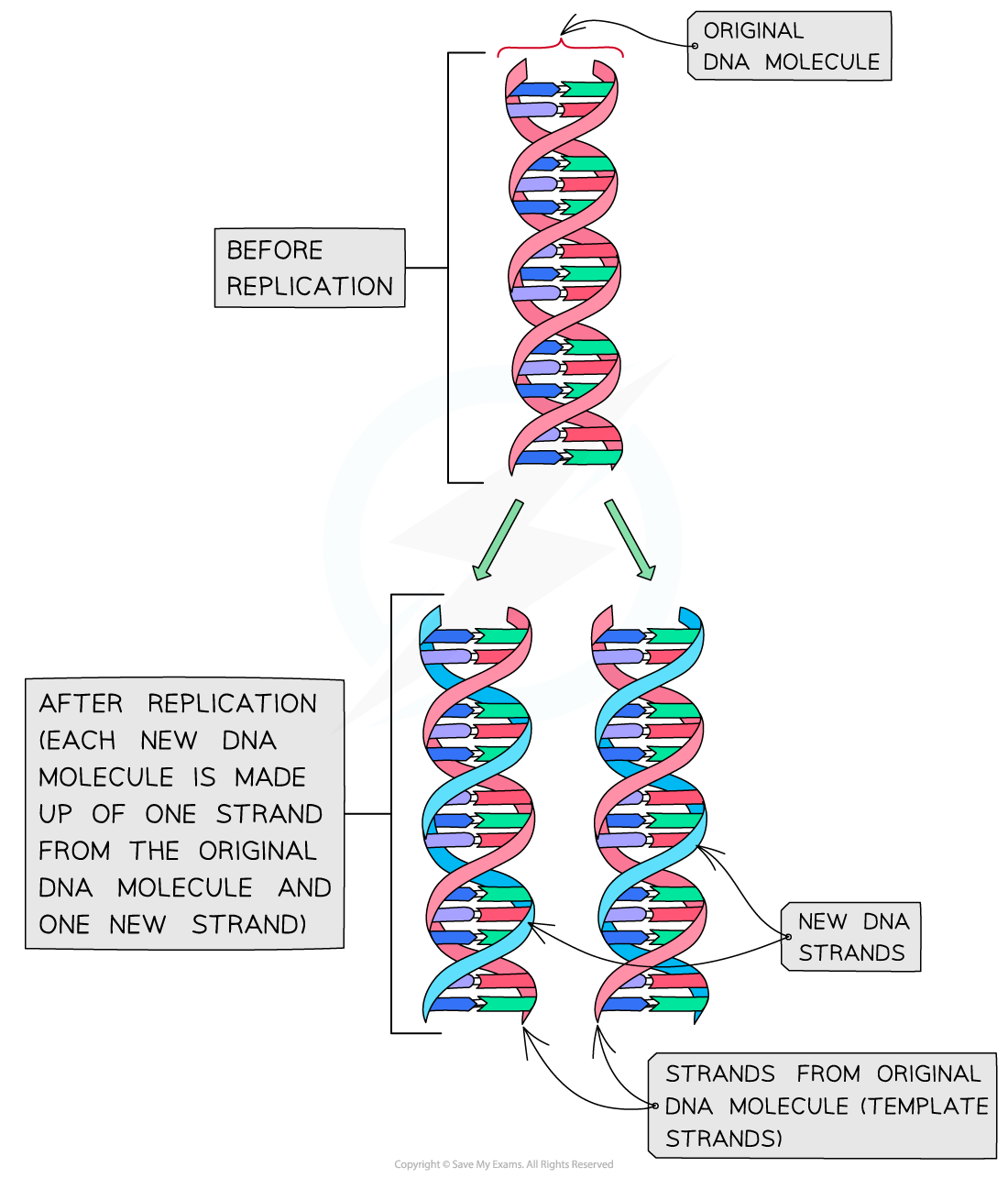Semi-conservative Replication of DNA
- Before a (parent) cell divides, it needs to copy the DNA contained within it
- Doubling the DNA ensures that the two new (daughter) cells produced will both receive full copies of the parental DNA
- The DNA is copied via a process known as semi-conservative replication (semi = half)
- The process is called this because in each new DNA molecule produced, one of the polynucleotide DNA strands (half of the new DNA molecule) is from the original DNA molecule being copied
- The other polynucleotide DNA strand (the other half of the new DNA molecule) has to be newly created by the cell
- Therefore, the new DNA molecule has conserved half of the original DNA and then used this to create a new strand
The importance of retaining one original DNA strand
- Retaining one original DNA strand ensures there is genetic continuity (i.e. genetic information is conserved) between generations of cells
- In other words, it ensures that the new cells produced during cell division inherit all their genes from their parent cells
- This is important because cells in our body are replaced regularly and therefore we need the new cells to be able to do the same role as the old ones
- Replication of DNA and cell division also occurs during growth
Semi-conservative replication
- DNA replication occurs in preparation for mitosis, when a parent cell divides to produce two genetically identical daughter cells – as each daughter cell contains the same number of chromosomes as the parent cell, the number of DNA molecules in the parent cell must be doubled before mitosis takes place
- DNA replication occurs during the S phase of the cell cycle (which occurs during interphase, when a cell is not dividing)
- The enzyme helicase unwinds the DNA double helix by breaking the hydrogen bonds between the base pairs on the two antiparallel polynucleotide DNA strands to form two single polynucleotide DNA strands
- Each of these single polynucleotide DNA strands acts as a template for the formation of a new strand made from free nucleotides that are attracted to the exposed DNA bases by base pairing
- The new nucleotides are then joined together by the enzyme DNA polymerase which catalyses condensation reactions to form a new strand
- The original strand and the new strand join together through hydrogen bonding between base pairs to form the new DNA molecule
- This method of replicating DNA is known as semi-conservative replication because half of the original DNA molecule is kept (conserved) in each of the two new DNA molecules

Semi-conservative replication of DNA
DNA polymerase
- In the nucleus, there are free nucleotides which contain three phosphate groups
- These nucleotides are known as nucleoside triphosphates or ‘activated nucleotides’
- The extra phosphates activate the nucleotides, enabling them to take part in DNA replication
- The bases of the free nucleoside triphosphates align with their complementary bases on each of the template DNA strands
- The enzyme DNA polymerase synthesises new DNA strands from the two template strands
- It does this by catalysing condensation reactions between the deoxyribose sugar and phosphate groups of adjacent nucleotides within the new strands, creating the sugar-phosphate backbone of the new DNA strands
- DNA polymerase cleaves (breaks off) the two extra phosphates and uses the energy released to create the phosphodiester bonds (between adjacent nucleotides)
- Hydrogen bonds then form between the complementary base pairs of the template and new DNA strands


Nucleotides are bonded together by DNA polymerase to create the new complementary DNA strands
Mutations
- The replicated DNA molecules must be an exact copy of the parent DNA molecule, therefore the formation of the complementary strands must be a highly accurate process
- Although the process is astonishingly accurate considering it is happening constantly in cells and at a considerable speed, occasional mistakes occur in the form of:
- Bases being inserted into the complementary strand in the wrong order
- An extra base being inserted by accident
- A base being left out by accident
- These mistakes in the process of semi-conservative replication of DNA result in the occurrence of random, spontaneous mutations (i.e. errors in the genetic code)
Exam Tip
Make sure you don’t confuse ‘parent cell’ with ‘parent organism’. A parent cell is any cell in the body that divides into two cells and the terminology is used to refer to the ‘original’ cell that the DNA came from before it was split and replicated semi-conservatively.

